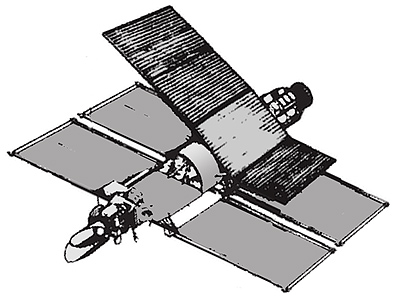Thank you very much for visiting Gunter's Space Page. I hope that this site is useful and informative for you.
If you appreciate the information provided on this site, please consider supporting my work by making a simple and secure donation via PayPal. Please help to run the website and keep everything free of charge. Thank you very much.
P80-2

P80-2 [Lockheed]
The Space Test Program P80-2 spacecraft was to be an Ascent Agena (similar to SEASAT) which is modified to carry orbital experiments on the forward structure. High electric power requirements are met by four flexible roll-out solar array panels which extend from the Agena. The twilight sun-synchronous orbit allows deployment of the array perpendicular to the insolation vector. Experiment data may be read out by ground stations or may be recorded for subsequent transmission to the ground stations. The investigations will test a deep-space-viewing infrared telescope with active cryogenic refrigeration, and measure solar flare isotopic composition.
P80-2 would have featured two prime payloads and a secondary payload:
- SIRE (Satellite Infrared Experiment)
This investigation employs an actively cryo-cooled telescope focal plane with multiple filter bands for observation of star and galactic radiance profiles and auroras. The telescope is gimbaled for 1-degree-of-freedom scans, relying on spacecraft maneuvers and optical FOV for additional observational scope. The refrigerator is an electrically powered vuillumier cycle machine of the type flown on previous STP flights. Cooling was to be provided by a deployable four sector radiator. The instrument was designed by Hughes Aircraft Company. - CRIE (Cosmic Ray Isotope)
The primary objectives of this investigation are to: (1) study solar flare energy conversion and solar acceleration mechanisms, and (2) monitor solar flare particle fluxes. Objective (1) is done through the identification of isotopes whose presence is a measure of the amount of solar matter traversed during acceleration and the time spent within the solar corona. The instrument package contains three multi-element solid-state detector telescopes. The high-energy telescope is used to resolve isotopes from hydrogen to nickel in the energy range 20 to 500 MeV/nucleon, and its view angle is 93 deg (full cone). The low-energy telescope is used to resolve isotopes from helium to nickel in the range 4 to 230 MeV/nucleon, and its view angle is 80 deg. The monitor telescope detects protons from 0.5 to 3.2 MeV and helium from 0.7 to 2.5 MeV/nucleon. Its view angle is 75.4 deg. Data rates are one 360 bit word/s for the high-energy telescope and one 360 bit word/s for the low-energy and monitor telescopes combined. - A space sextant was the secondary payload.
P80-2 would have been launched by an Atlas-F Agena-D launch vehicle from Vandenberg Air Force Base, but was cancelled due to a 19 million USD cost overrun in spacecraft integration. The SIRE instrument was then planned to be flown as an attached (sortie) payload on the Space Shuttle, but was eventually cancelled.
| Nation: | USA |
|---|---|
| Type / Application: | Technology, science |
| Operator: | US Air Force (USAF) |
| Contractors: | Lockheed Missiles and Space Co., Ball Space Systems, Jet Propulsion Laboratory (JPL) |
| Equipment: | SIRE, CRIE |
| Configuration: | Agena-D with payload module |
| Propulsion: | Bell 8096 |
| Power: | 4 flexible roll-out solar arrays, batteries |
| Lifetime: | |
| Mass: | 2430 kg |
| Orbit: | 740 km × 740 km, 98.30° (planned) |
| Satellite | COSPAR | Date | LS | Launch Vehicle | Remarks | |
|---|---|---|---|---|---|---|
| P80-2 | - | cancelled | Va SLC-3W | Atlas-F Agena-D |
References:
- NSSDC Master Catalog: STP P80-2
- G. C. Gibson et al.: The attitude control and determination system for P80-2
